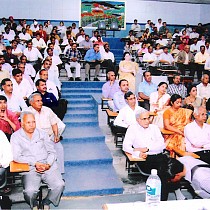BIOEFFICACY OF ENTOMOPATHOGENIC FUNGAL FORMULATION OF METARHIZIUM ANISOPLIAE (METCHNIKOFF) WITH ADJUVANTS IN THE MANAGEMENT OF MANGO HOPPERS IN MAHARASHTRA
Assn. Prof. of Agril. Entomology, Dr. B.S.K.K.V, Dapoli, 'Assn. Prof. of Agril. Entomology, M.P.K.V., Rahuri, 'Prof. of Agril. Entomology, M.P.K.V., Rahuri,'Assoc. Prof. of Agril. Entomology, M.P.K.V., Rahuri, 'Ass°. Dean, College of Agriculture, Karad, M.P.K.V., Rahuri,
A. S. DHANE, N. D. TAM HOU, D. S. POKHARKAR, R. V. NAKAT AND S. B. KHARBADES
Mango (Mangifera indica Linn.) is a an important and popular fruit in the world. More than 300 insect pests have been recorded to infest mango crop in different regions of world. Mango hoppers have been recognized as the most noxious insect pest causing damage almost every year throughout the country to mango crop. Hopper may cause up to 50 per cent crop loss in cases of severe infestation. Keeping aforesaid facts in view, the experiment was carried out with an objective to evaluate Metarhiziwn anisopliae fungal formulation with adjuvant against mango hoppers under field conditions. The trial was laid out in the mango orchards at Regional Fruit Research Station, Ganeshkhind, Pune for three consecutive years during 2011 to 2014.The results indicated that Metarhiziwn anisopliae @ I x 10' spores/ml during off season in the month of December followed by four sprays of the pathogen mixed with adjuvant (sunflower oil 1 ml/lit + Triton-X 100 @ 0.1 mlllit) at weekly interval during flowering were found significantly superior over other treatments in suppressing the hopper population and increased fruit setting. The mean surviving population was recorded as 10.98 hoppers and 11.82 fruit sets per inflorescence. The untreated control block recorded 54.39 hoppers and 6.01 fruits set of mango per inflorescence.


